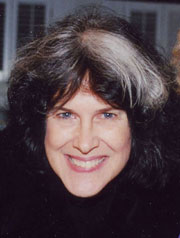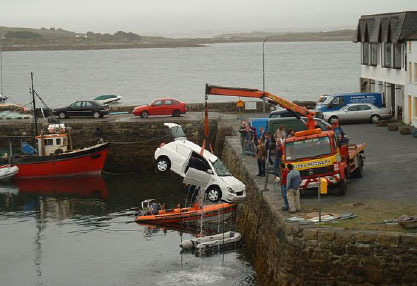 |
→ November 2005 Contents → E-bits
|
E-Bits:
Equanimity |
 |
||||||||||||
|
If any of us are not reeling from recent events, then please write immediately with tips on how to achieve effortless equanimity and equilibrium. We seem to be caught on a permanent basis inside the tent of a three-ringed circus, with drama unfolding under every spotlight. More natural disasters in the forms of the Hurricane Wilma in the Caribbean, Latin America and Florida, mudslides in Guatemala, and the devastating earthquake in South Asia, have us asking, "What is going on?" The White House arena has been supercharged, whipping everyone into a frenzy with the wildly unpopular, now-withdrawn nomination of Harriet Miers to the Supreme Court, while all looked with wide-eyed anticipation to an event dubbed by some as "Fitzmas," the initial phase of the culmination of the CIA leak investigation.
After rampant and runaway speculation in the peanut gallery, a sparse but significant delivery of a lone indictment to a guy named Scooter was made by the special prosecutor. Whether Scooter will, in the end, represent the tip of an iceberg or the bad apple in the bunch is unknown for now, and everyone is keeping an eye on events to follow. Another drama last month was the vote to ratify the proposed Iraqi constitution. The resulting "yeas," having it by an overwhelming margin, were met by suspicion and skepticism, and the subsequent audit proved the ratification narrowly escaped defeat after all. What cannot be called anything but tragic is reaching the milestone number of 2,000 U.S. military servicemen and women killed in Iraq, the number continuing to climb relentlessly. This 2,000 number reflects maybe 2 percent or less of those killed, injured or maimed, including U.S., Iraqi, military, insurgents, civilian and otherwise. It is hard to believe we have seen all of these events in just one month. Powerful voices in the antiwar movement are making themselves heard, as evidenced by this video circulating the Web.
There is an acronym that originated in the military for a normal situation not being normal at all. Many of you may in fact use it regularly: SNAFU. Situation Normal All Fouled Up (polite). Inspired by events of late, I entertained myself briefly by googling "snafu," which has now achieved the status of an actual word as well as an acronym. Did you know that the plural of snafu is snafus? Why not s'snafu? Then there's the verb—the willful form of creating confusion: to snafu; things are snafued; he or she snafus; they are snafuing. Following is an example of an innocent but progressive snafu, photos that at the very least cause one to ponder ineptitude, as if Murphy's Law is now a mandate. Snafu here turns to FUBAR, or, as they say, "beyond all repair." Somehow, this progression elicited a chuckle from me, which may be your response. Click on the photo to see the unfolding of a progressive failure.
Getting back to the idea of equanimity and equilibrium, let's think about those two words for a moment. Equanimity means calmness and even-tempered composure under stress, a steadiness of mind in spite of duress. Equilibrium, on the other hand, refers to a balanced and stable state in which all acting influences are cancelled or invalidated by others, or, to be more precise, the state of zero-sum. It seems we sometimes attempt to counteract every action with an equal or opposite reaction, but is zero-sum what we really want? By very definition, equilibrium is achieved only after all response ceases, a situation forced into stagnation and stability via the end of a fencing match between action and reaction. We know that constant change is really the nature of nature, so maybe what we should go after is not equilibrium but equanimity—calm endurance on a wild roller-coaster ride that never ends. It's the anticipation of "The End" that is so scary, but if things are in constant change, then every moment is not only The End but also The Beginning. The photographers in the following photos would argue this Zen-like point, however, and so might the viewer; here The End looks like The End. You'll recognize the last photo from previous E-Bits, of a bull charging fast and furious in the direction of the photographer in Pamploma, Spain, during the running of the bulls. Which is your pick for the aptly titled THE LAST PHOTO I EVER TOOK CONTEST?






One thing we can count on, hopefully, is creative change. There is a saying that when a system in nature breaks down, that it always reorganizes on a higher level. That's not absolutely true, but it sounds good, and we know from examples ranging from genius of design in architecture to evolutionary mutations in biology that it happens at least sometimes, if not often. We do have a creative urge to find out how to build a better mousetrap, or even how to build a better mouse. A bit of good news for disaster-sieged New Orleans is that others elsewhere have forged better ways to battle the forces of storm surges and flooding by designing better systems than the levees that breached with such tragic consequences in September. Consider these next photos.
Surely better days are ahead and solutions are at hand. There are a lot of things to be accounted for, fixed, righted, reversed and healed. One of the most inspiring activities on the world stage at the moment is charitable relief, and though the supply does not quite meet the demand, there are opportunities for involvement on many levels, whether donating time, money or talent. Young and eager photojournalists may not know there is work available to them within charitable organizations. One of our readers, Scott Harrison, is a photojournalist for one such humanitarian agency, Mercy Ships. Scott works on a 522-foot surgery ship off the coast of Liberia, West Africa. His photos were recently exhibited along with that of 99 other photographers in New York City and touted by several major publications. At the end of his e-mail he included a quote by Carl Jung (1875-1961): "There can be no transforming of darkness into light and of apathy into movement without emotion." Attaining the emotional transcendence that is equanimity, without withdrawing from tragedy or ignoring the sweeping changes at hand, is a challenge for us all. One way to do it is by donation or service to humanitarian causes. Learn about Scott Harrison's experiences in finding his own equanimity as a photojournalist on a surgery ship by viewing his Web site.
Ask young people what they want to do with their lives, and often they will say they are going to save the world. "He Went to Paris," a thought-provoking song written by Jimmy Buffett in 1973, recounts the life of an old man who in his youth wanted just that. Click on the lyrics to hear the song.
And the last verse...
Like the hero in the song, we soon find out that not one of us can save the world on his own, but together, we might be able to help in significant ways, large or small. I'm going to keep that in mind as we sail toward December.
© Beverly Spicer
The links that appear in this column are from the World Wide Web. Credit is given where the creator is known. The Digital Journalist and the author claim no copyright ownership of any video or photographic materials that appear herein. |
|||||||||||||
Back to November 2005 Contents
|
|








